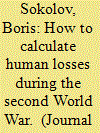|
|
|
Sort Order |
|
|
|
Items / Page
|
|
|
|
|
|
|
| Srl | Item |
| 1 |
ID:
090930


|
|
|
|
|
| Publication |
2009.
|
| Summary/Abstract |
One of the most controversial questions dominating the historiography of the Second World War is that of determining the human cost of this struggle, in particular, the losses suffered by the Soviet Union and its Red Army during this most terrible of 20th century wars. The sheer immensity of these losses, coupled with the radically shifting European borders during and immediately after the war that complicated the task of calculating losses, demonstrates just how formidable, if not utterly futile, this task really is. As a result, estimates of the human losses the Soviet Union's population and military suffered during the war vary widely depending on such factors as the nationality and ethnicity of the author and the methodology the author employed. This article, written by a Russian journalist and historian, presents one of the most radical and gruesome of existing estimates.
|
|
|
|
|
|
|
|
|
|
|
|
|
|
|
|
| 2 |
ID:
090929


|
|
|
|
|
| Publication |
2009.
|
| Summary/Abstract |
The Maritime Military School System, with its mission to have future officers up and ready to serve on combat ships of the Polish Navy, has been in operation for nearly 90 years. This School System was first introduced in 1921 and although it has, over all these years, undergone numerous changes, its mission remains just the same - to foster new generations of Polish best naval officers. Its hitherto existence may be divided into four main periods: (a) from 1921 through 1939, encompassing the time of efforts to prepare sufficient cadres for the rising maritime and river flotillas. Those efforts, however strenuous, proved fruitful and brought us officers whose professionalism evidenced itself during WWII hostilities at seas and oceans; (b) from 1939 through 1945 - when the Polish Maritime Military School System operated in exile, most notably in the United Kingdom. It's graduates excelled at warfare and won acclaim from the leadership of the Allied Forces; (c) from 1946 through 1991, epitomized by incessant changes with a view to modernize educational and training processes and address requirements of the theater of operations. Good sense of direction behind those changes is evident and confirmed by our allies - the NATO members; (d) which has continued since and featured political transformation and alignment with NATO. And once again the School System yields acclaimed cadres who, in turn, may take pride in serving under the white and red flag.
|
|
|
|
|
|
|
|
|
|
|
|
|
|
|
|
| 3 |
ID:
090922


|
|
|
|
|
| Publication |
2009.
|
| Summary/Abstract |
The triangulation of U.S.-Russian nuclear arms reductions, nuclear abolition, and nonproliferation creates problematical paradoxes and issue overload for the currently challenged policy making processes throughout the international community. Success in Russian-American strategic arms limitation is a necessary condition for further success in nonproliferation, but not a guarantee of eventual success. Interest in nuclear abolition and in missile defenses complicates linear and time tested approaches to nuclear arms limitation, although not fatally.
|
|
|
|
|
|
|
|
|
|
|
|
|
|
|
|
| 4 |
ID:
090925


|
|
|
|
|
| Publication |
2009.
|
| Summary/Abstract |
Ever eager to capitalize on economic opportunities or play a role in global security affairs, Moscow has maintained a disturbing yet continuous pattern in the weapons trade business with Iran and Syria. While the West remains fixated on Iran's uranium enrichment program, little attention has been paid to the stockpile of advanced Russian weapons that Iran and Syria have accumulated throughout the years. Military tensions with the West will only further solidify the Russian, Iranian, and Syrian alliance and ensure Moscow's client base for years to come.
|
|
|
|
|
|
|
|
|
|
|
|
|
|
|
|
| 5 |
ID:
090927


|
|
|
|
|
| Publication |
2009.
|
| Summary/Abstract |
The article is devoted to the role of Yugoslavia in the foreign policy of the United States of America in the region of Eastern Europe in the 1960's and 1970's. The author underlines the importance of Yugoslavia to the United States in its "wedge strategy" directed towards the Soviet Bloc countries. It points out the role of economic relations and humanitarian cooperation in the achievements of the United States foreign policy aims during the Cold War era. The author describes the role of Yugoslavia in the process of encouragement of economic and political reforms towards liberalization in other Eastern European countries and defines the factors which justified the special role of Yugoslavia in American foreign policy. The author also analyses the role of Yugoslavian immigration in the development of American-Yugoslavian relations and defines the main directions of American foreign policy towards Yugoslavia after the withdrawal of J.B Tito from the political arena.
|
|
|
|
|
|
|
|
|
|
|
|
|
|
|
|
|
|
|
|
|